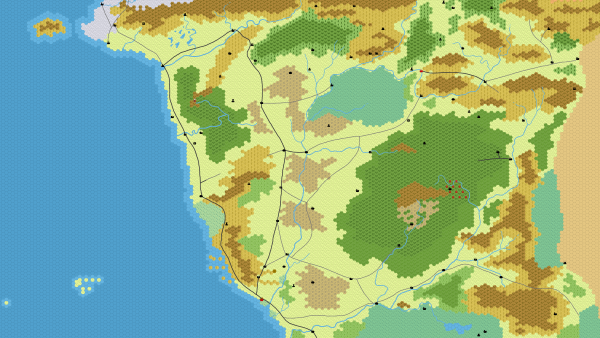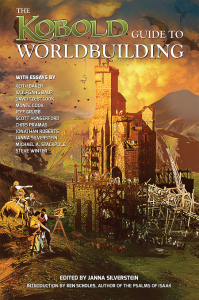To get a familiar reference of scale for my own maps, I created this Hex map of the Savage Frontier region of the Forgotten Realms.
 If you’re interested in it, you can get it at full size here.
If you’re interested in it, you can get it at full size here.
A version without any map icons can be found here.
Yora's site for Sword & Sorcery RPGs
When I started working on the Ancient Lands, I wanted of course to create a world that contains many of the things I already love in other settings, but would wish to be more explored or developed a bit differently. Not all the things I love, because that doesn’t really lead to consistend and belivable world, but rather to a mess of randomly thrown together pieces. But still a selection of a good amount of things from my favorite settings that I have come to love a lot. Here, I want to provide an overview of the major geographic areas of the Ancient Lands and the works that inspired them. These don’t cover the whole world, or even the whole continent, but are the selection I made for those regions I want to develop in detail, while leaving the rest simply untouched. There’s something there, of course, but I don’t know what it would be either.
One thing most GMs will realize probably quite quickly is that you can’t really start a great campaign with “You are all meeting in a tavern” (unless you’re going for a pure treasure-hunting dungeon crawl, I suppose). Even if you have an overarching story in mind, it’s often difficult to slowly build up to the really big issues that will define the campaign. At first you get to kill some rats in the basement and then slowly work your way up until you eventually get to explore a goblin lair where the actual hook for the major part of the campaign will be found. And as easy as it sounds, it’s quite difficult to make it work well and be exciting and enjoyable for the players.
Fate presents an interesting take on this: Every new campaign should start with at least two big issues (though don’t overdo it or it gets too cluttered and confusing). These can either be current issues or impending issues. Impending issues are the things I just mentioned. The definitive story with a clear villain and a specific goal for the PCs. But something that seems to be usually overlooked in RPGs are the current issues. Instead of dropping the players into a world where everything is mostly fine until they run into the plot hook, you can (and I think should) also start the campaign with some kind of major conflict or other problem already in place. It’s something that is very common in fiction and in many videogames as well. Take for example, once again, Star Wars, where there is already dissent against the new public order and rebellion brewing in secrecy before Luke and Han get involved in the actual plot at all. It’s the background environment in which the specific adventure of delivering the Death Star plans and saving the princess takes place. It’s the context for what they do and makes that simple delivery run matter, even before they end up joining the rebellion and taking up the goal of defeating the Empire. The game Skyrim is also a good example. You get the Dragon storyline as an Impending Issue that slowly builds up during the first three or four hours of the game, but there is already the Stormcloak uprising against the Empire as the Current Issue, which has been going on for quite some time before the players character gets drawn into the story.
Now I really wish I had been thinking about this a week ago, so I could have made use of this simple method to start my new Castles & Crusades game, but with only the first session played so far, it should be easy enough to do this retroactively.
I am starting a new campaign set in the Ancient Lands tomorrow, and as so often I find myself a bit doubting about the setting really being something different and not just another case of generic european middle ages fantasy. So kind of as a last moment effort, I sat down once more, going over notes to remind myself of some special features I’d fallen in love with over the last years.
These are not things that are going to feature in any significant way in the first adventure of the new campaign, but by mentioning these things every so often while describing what the PCs are seeing, I am hoping to get the players to see the world as more than just Europe with orcs and dragons.
Earlier this week I mentioned between classes that I’d really like to play an RPG again. And as luck has it, my friends all got quite excited about the idea. Only two of them have actually played any games before, but all the others are also quite enthusiastic and so I know have 6 players already and a good chance that this game will keep going for two or three years. The kind of opportunity every small-time GM would wish for.
I’ve decited to ditch Pathfinder and instead go with Castles & Crusades, which is much easier to learn, faster to play, and allows much more freedom because preparing for multiple possible outcomes requires much less time and work, and I can even make up things on the fly. However, having always run rather linear games in which there was a clearly structured sequence of setpieces, I don’t really have any experience with planning a much more open-ended campaign. While I like the possibilities of sandbox games, I don’t want to make it a hexcrawl, but instead provide an interesting starting situation in which the players are free to take sides and steer events towards and outcome that is in their favor. There probably is a huge amount of information out there on the subject and reports of campaigns that people actually ran, but finding those is the difficult part.
If anyone has any pointers towards articles, campaign reports, and similar sources, it would be hugely appreciated if you could share the links in the comments.
Creating a setting for an RPG is a quite different thing than creating a world for a novel or a movie, or even a TV show or video game. In a normal story, the writers control what characters will be appearing and what places they will visit and what kinds of people they will meet. Everything only has to be consistent with the rest of the story and you can make up new things as you go along. A writer can even go back and change things during editing before the final work is released. Creating a campaign setting for an RPG is different, especially if you write it not only for use in your own campaigns as a GM, but might make it available to other people as well. You don’t know who the characters will be and only have limited control over what places they will be visiting because everything can still change as the story develops. To make a good campaign setting, you always have to think of a larger world, even if it is only the size of a single country or city. (Though in my experience, most new setting creators go for entire planets or at least continents, which I think is actually too grand a scale.)
But where do you start? There are a couple of guides out there, mostly online but also in print, that attempt to provide a good overview over the subject of worldbuilding and hand the reader a kind of step-by-step checklist. The AD&D Worldbuilder’s Guidebook is probably one of the most well known, but once I got the opportunity to give it a read I found it rather lacking. Yes, first you start with a globe (or other type of body), then you decide what is water and what is land, place the mountains and rivers, forests and deserts, kingdoms and towns, and so on. But unless you really have no clue at all about the creation of a new fictional world (in which case you’re probably not the main audience for such guides), these are things you all already know. The real questions are how you create a world in a way that it is exciting, unique, and has real traction, and avoid it just being generic, inconsistent, and overly exotic to the point of getting silly?
 Earlier this year, I stumbled upon The Kobolds Guide to Worldbuilding, and it turned out to be just the kind of book that adresses exactly these things!
Earlier this year, I stumbled upon The Kobolds Guide to Worldbuilding, and it turned out to be just the kind of book that adresses exactly these things!
Continue reading “Review: The Kobold Guide to Worldbuilding”